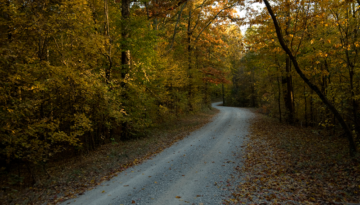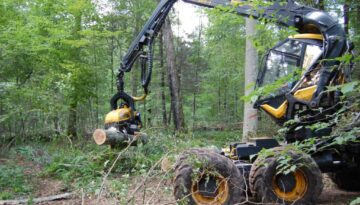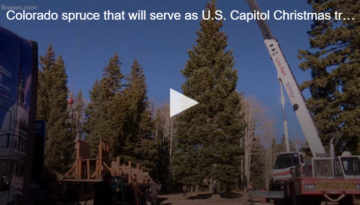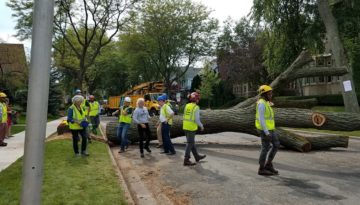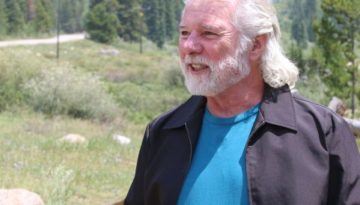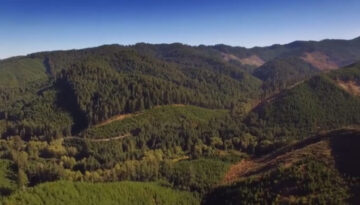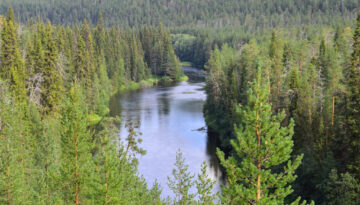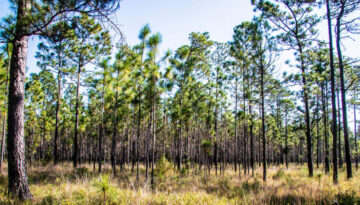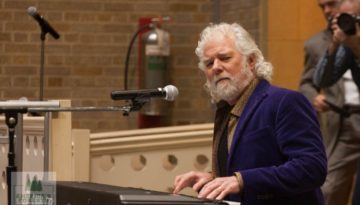Only the occasional song of native birds interrupts the silence within a thickly wooded area of northeast Wisconsin, a forest so dense that any stranger to the land could easily become lost.
Suddenly, Menominee tribal contractor Jeff Dixon rolls through with heavy machinery to move harvested logs and clear a path for other vehicles.
He’s careful not to damage any of the hundreds of surrounding trees because he knows that kind of attentive management has helped sustain his family for generations and his tribe for thousands of years.
The Menominee Forest on the Menominee reservation is often touted by experts as the largest single tract of virgin, native timberland in the Great Lakes region. Its natural resources provide a trove of benefits to Wisconsin and it’s seen as an example of how a forest should be managed.
The forest is clearly recognizable in satellite images and its greenery stands out during the nightly TV news weather reports in Doppler radar, especially because its dense canopy is surrounded by agricultural lands.
The Menominee Forest is not used as a recreation area for tourists, and its role in the state has gone largely unnoticed. Yet these woodlands provide more fresh air to millions of people than other forests in the Upper Midwest and are a haven for native Wisconsin wildlife rarely found elsewhere.
The forked tree to the right is targeted for harvesting while the healthy tree on the left will be left to grow by Menominee Tribal Enterprises in the Menominee Forest.
“Wildlife and even plant populations do not just live within the political boundaries we humans establish, so large, healthy forests benefit those populations for the landscape as a whole,” said Gregory Edge, a forest ecologist who’s worked for 28 years with the Wisconsin Department of Natural Resources.
Interior forest songbirds, for example, rely heavily on large, intact native forests, such as the Menominee, to help them establish in new areas.
A 2018 study published by University of Wisconsin and Dartmouth professors found tribal forests, such as the Menominee in northern Wisconsin, had larger, more mature trees and were able to store more carbon than state or private forests in the region.
The study also found that tribal forests maintained their diversity of native plants beneath tree canopies much better than non-tribal forests.
Gregory Edge, forest ecologist for the Wisconsin Department of Natural Resources
Wildlife and even plant populations do not just live within the political boundaries we humans establish, so large, healthy forests benefit those populations for the landscape as a whole.
The Menominee Forest, which almost entirely fills Menominee County about 60 miles northwest of Green Bay, is a great example of what a forest should be, according to Darrell Zastrow, retired deputy administrator of the DNR.
So impressive was their work that tribal foresters helped the DNR develop guidance in proper forest management for Wisconsin, he said.
Never touched by Americans of European descent
One reason the Menominee Forest is much healthier than others in the region is because it was spared from exploitative waves of heavy logging, in which millions of acres of forests in the Northwoods in Wisconsin, Minnesota and Michigan had been clear-cut for timber in the late 1800s and early 1900s.
Waves of clear-cutting first targeted white and red pine that could be floated down rivers, and a second wave removed hardwoods once railroads were installed, Edge said.
“Most of the northern Wisconsin forests are second-growth forests,” he said.
The Menominee Forest is considered a primeval forest largely untouched by Americans of European ancestry.
The Menominee tribal lands once spanned much of northeastern Wisconsin and into Michigan, but after negotiation and diplomacy with the U.S. government, the tribe was left with a reservation of 235,000 acres, of which about 95% is forested.
Adrian Miller, president of Menominee Tribal Enterprises, which manages the forest and the tribe’s sawmill operation, said the government also tried to make the Menominee move from their current reservation. But tribal members refused to move and government officials reasoned the land wasn’t worth going to war over because it wasn’t ideal for farming, Miller said.
Sustainable management of the forest by the tribe over the years has led to a much healthier ecosystem, according to the DNR’s Edge.
“The management is much more consistent compared to other forests in the state,” he said.
The native forest has been able to repel invasive plant species, such as the European buckthorn, which has plagued woodlands across the country.
The plant, which was brought by farmers for use as a kind of fence, is invasive because it spreads rapidly, has shallow roots that don’t help much to mitigate flooding or erosion, and buckthorn doesn’t allow other plants to grow near it because it consumes much of the sunlight.
Menominee Tribal Enterprises employs careful precision to sustainably harvest the Menominee Forest.
Greater road density in non-tribal lands also played a role for exotic plant species to invade federal forests in the region, causing loss in native plants from competition, according to the 2018 study.
Larger deer populations are also found in non-tribal forests and the whitetails’ activities are attributed to the lower survival rate of tree seedlings. Deer are less prevalent in tribal forests because of fewer roads and houses providing fewer forest edges where the animals thrive, the study found.
Just a few feet from carefully managed logging operations in the forest, trees rise into the sky — not competing, but complementing each other with their hunger for light.
The forest floor is filled not with impassable buckthorn but with easily traversable paths through native plants, such as ferns, a rare sight in other woodlands.
The Menominee Forest also boasts some of the best examples of native trees in the region. This is, in part, because of techniques innovated by the tribe, such as helping to regenerate white pine forests.
The method includes removing competing tree species and then disturbing the forest floor to make conditions favorable for seed germination, such as through prescribed burning.
“MTE (Menominee Tribal Enterprises) was instrumental in developing many of these techniques for white pine regeneration in Wisconsin,” Edge said.
The tribe has been able to blend traditional knowledge with scientific methodology to help maintain one of the healthiest timber forests in the Great Lakes area, he said.
A forest with a $37 million treasure – The tribe has been methodically harvesting trees in its forest to generate revenue to support its people since 1908.
Up to 20 million board feet of timber are harvested annually from the Menominee Forest, providing an estimated $37 million annual impact on the reservation’s overall economy and providing hundreds of jobs.
(The forest) is the most important thing in my life other than my family.
Of the nearly 300 people employed directly by Menominee Tribal Enterprises, about 160 work at the tribe’s sawmill during the peak of the season.
Jeff Dixon contracts with Menominee Tribal Enterprises, and the the forest has been the lifeblood of his family for generations. He had taken over the logging business from his father and hopes to one day pass it to his son.
“(The forest) is the most important thing in my life other than my family,” he said.
Dixon said he recognizes how timber from the forest helps sustain the economic health of the reservation and its people. Logging also has been good for him, personally, for four decades.
“I love being outdoors and I love working in the woods,” Dixon said. “No one is telling me what to do.”
“It’s kept me going for over 40 years, and I see no end to it,” he said.
He said a reporter once questioned and criticized him for seemingly cutting down too many trees, but Dixon said outsiders don’t understand the process of sustainable management and forest regeneration.
There are parts of the forest that naturally regrow so quickly that he’s been able to log those same areas multiple times over his career.
The trees are harvested in a way that will allow the forest to continue to support future generations on the reservation, said Miller, the president of Menominee Tribal Enterprises.
“MTE has sustainably managed our forest through the wise words of Chief Oshkosh,” he said, making reference to the chief of the Menominee in the 1800s who played a key role in treaty negotiations with the federal government.
Long-term goals come at cost of short-term profits
That connection to the land is something Miller hopes to help outsiders understand.
“This vast ecosystem has sustained this tribe for thousands of years,” he wrote to the Forest Stewardship Council, which recently audited the Menominee Forest. “This emerald giant is more than a forest, it is our spiritual home.”
Certification of tree resources by the Forest Stewardship Council is a standard-bearer in the paper-making industry, and MTE was an early adopter of the audit process.
But Miller wanted to make sure representatives of the Germany-based organization understood the Menominee Forest is more than just a resource for its people.
“We are part of the forest and the forest is part of us,” he wrote. “What we do to the forest we do unto ourselves.”
Andrew Miller, president of Menominee Tribal Enterprises
This vast ecosystem has sustained this tribe for thousands of years.
One major difference in practice from other harvested forests is that the tribe leaves the strongest and most valuable trees in place and removes trees that are dying or diseased for lumber.
Even the tribe’s sawmill is surrounded by trees.
“We don’t jump at the easy dollar,” Miller said.
Precision, rather than clear-cutting, techniques are employed — that requires “hand-sawers,” or lumberjacks, to enter the forest with chainsaws and make exact cuts so as not to harm any surrounding healthy trees.
The removal of the unhealthy trees also allows younger, healthy trees to grow nearby, according to Mike Lohrangel, an MTE employee whose job it is to make sure lumberjacks don’t harm healthy trees in the Menominee Forest.
Other trees cleared for removal include those that are double-forked or those that will likely become diseased in the near future, such as ash because of the emerald ash borer infestation in the U.S.
Menominee Tribal Enterprises employs careful precision to sustainably harvest the Menominee Forest.
Unhealthy trees might also be protected if certain animals have made them into a home; an eagle’s nest, for example, would prevent it from being logged.
This careful management may mean that MTE does not profit nearly as much as other timber operations in the short term, Miller said, but it also means the forest will remain an important part of Menominee identity.
“The burden of managing a forest sustainably bodes well long term for MTE’s competitiveness as an elite forest manager, but does not pay for itself in this current fiscal year,” he wrote to the stewardship council. “It is now sustainable in the ecological sense, but not economically.”
URL: https://bit.ly/3b10511

